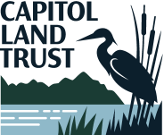Brown Preserve
Conserved in 2001 and 2017
Property Overview:
- In 2017 Capitol Land Trust purchased 49 acres from George and Marcia Brown along the shoreline of Henderson Inlet, west of Johnson Point Road in northern Thurston County.
- The Browns donated a conservation easement over a portion of the property in 2001 but later wanted it to be a nature preserve and approached Capitol Land Trust to purchase the property.
- This property contains three wetland systems, several streams, a rare, pristine, estuarine environment, as well as mature coniferous forest adjacent to the marine environment, and mixed upland deciduous and coniferous forest communities.
- Wildlife habitat on the Brown property provides protection for great blue heron, bald eagle, deer, coyote, osprey, pileated woodpecker, shellfish, and several salomonids, such as chum, coho, steelhead and cutthroat trout.
Thank you to the following partners:
- George and Marcia Brown
- Jennifer Hayes
- WA State Department of Ecology
- US Fish and Wildlife Service
- WA Salmon Recovery Funding Board
CLT Strategic Conservation Goals Achieved:
- Conserve wetlands, riparian areas, and associated upland forests.
- Conserve marine shorelines and estuaries.
Notes from the Field: Brown Easement
by Shelley Kirk Rudeen (Issue 36 Winter 2002)
If you approach the Brown property like a deer, you’ll wander through green light falling among maple trees. Picking your way along ragged wetland edges of the little creek, you’ll browse on tender salmonberry now in bud.
If you fly in like a bald eagle, you’ll carry clouds on your shoulders and pause to hunt from a perch in the canopy of old fir and hemlock.
If you arrive like the rain, you’ll sweep across Henderson Inlet, searching out long fingers of the small estuary. You’ll collect in heavy drops hanging from cantilevered madrone trees, and fall to saltwater in a subtle chorus of hollow tones, like bamboo chimes.
If you get here like I did, you’ll wear boots and brush pants, with rite-in-the-rain paper in one hand and binoculars in the other. Then you’ll have to decide what to look at first. Just 32 acres, the Brown property is a remarkably diverse addition to the Trust’s portfolio of conservation easements. The property boasts a deeply incised saltwater shoreline, mature forest, younger alder stands, and two wetland riparian stream corridors.
This sort of diversity is heaven for birds. Wintering waterfowl float in the two arms of the estuary at high tide, and shorebirds patter in the mud at low. Raptors make good use of shoreline trees, as well as snags interspersed in the forest, for their hunting perches. Snags are numerous. They come in all sizes and stages of decay – an open invitation to woodpeckers.
Even in winter, woodland birds are present. A brown creeper explores every nook and cranny of the bark on a fir tree. Nearby, a ruby-crowned kinglet – solitary as usual – forages in the understory while its cousins, a flock of gregarious golden-crowned kinglets, chatter in the branches. Come spring, the varied forest structure will play host to more species of woodland songbirds. Many will arrive from Central and South America. While our southern neighbors work to preserve the wintering grounds of these birds by cultivating shade-grown coffee and preserving tropical rainforests, the Trust helps us northern types do our part by preserving woodland and wetland breeding areas.
According to the habitat inventory prepared for the Brown property, the saltwater shoreline is the most valuable wildlife habitat there. In addition to supporting numerous waterbirds, the unvegetated intertidal zone is home to untold numbers of marine invertebrates that burrow in the mud or drift in the water column with the murky tide. Woodland Creek’s fragile salmon runs migrate along the wild shoreline – juveniles making the dash for open ocean and adults returning to spawn.
But it is the streams that interest me the most: the way they meander through deep, fern-covered ravines; the saturated soils of wetlands flanking the little watercourses; the spill of stream to bay creating little estuaries.
What if you could come here as the skunk cabbage? Pushing upward from winter-wet muck, unfurling your yellow cowl, you’d release the pungent perfume that signals: Spring’s here! And all’s well, for this habitat has been protected!

